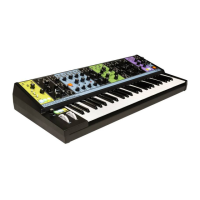22
RESONANCE 1 & 2
Resonance channels a portion of the Filter’s output back
to the input of the Filter, creating an emphasis peak at the
Filter’s Cutoff frequency. This is useful for adding focus,
funkiness, or “sci-fi laser blasts” to a sound.
The RESONANCE 1 knob sets the amount of Resonance
being applied to VCF 1, while the RESONANCE 2 knob sets
the amount of Resonance being applied to VCF 2.
NOTE: A RESONANCE knob setting of around 3 O’clock or more will cause the filter to self-oscillate.
ENVELOPE AMT (Envelope Amount)
The ENVELOPE AMT knob determines how much of the control signal created
by the Filter Envelope will be applied to the Filter’s Cutoff frequency over
time. This knob is bipolar, so turning the ENVELOPE AMT knob clockwise from
center will raise the Filter’s Cutoff frequency from the CUTOFF knob’s current
setting. Turning it counterclockwise from center will lower the Filter’s Cutoff
frequency from the CUTOFF knob’s current setting.
NOTE: Negative (or inverse) modulation simply flips the shape of the Filter Envelope
generator. Instead of the Attack parameter raising the Cuto frequency over time,
the Attack parameter will lower the Cuto frequency by the same amount, in the
same period of time.
KB TRACKING (Keyboard Tracking)
Keyboard Tracking allows the note being played on the keyboard itself to be
used as a modulation source for the Filter’s Cutoff frequency. Higher notes on
the keyboard may be perceived as being brighter than lower notes – especially
when the filter is in the Low Pass mode.
When the KB TRACKING knob is set to its maximum value (fully clockwise),
the Filter will track the keyboard using the same 1 volt/octave scheme as the
oscillators. At its minimum value (fully counterclockwise), the KB TRACKING
knob will have no effect.
TIP: Setting the RESONANCE and KB TRACKING knobs to maximum allows the
keyboard to play the Filter(s) similarly to an oscillator.
FILTERS (Continued)

